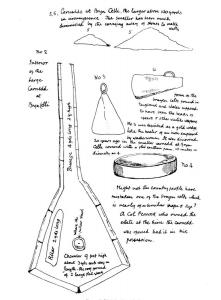Archaeologia Cambrensis 1908 Supplement 03 December 1802
Archaeologia Cambrensis 1908 Supplement 03 December 1802 is in Archaeologia Cambrensis 1908.
03 Dec 1802. Accompanied by a young farmer who procured a lanthorn for the purpose we walked nearly a mile to the south east of the church to the spot where in Mr. Rowlands' time there were two carnedds [Bryn Celli Ddu Burial Mound [Map]] remaining having two rude stone pillars placed between them but these stones have been employed for the purpose of building a wall near this place as well as a great part (fol. 45.) of the western carnedd which is nearly destroyed for the same purpose about twenty years ago when the labourers when digging towards the center discovered a flat pan about ten inches over-turned bottom upwards and under it a wedge of gold as they pretend the size of the heater of an iron with a piece of wire passing through the smaller end of it. The father of the young man who was with us happened to be one of the workmen employed at the time, but as what they found was immediately taken by Colonel Peacock the proprietor of the ground the man could give no further account of the circumstance. I should imagine that what they called the wedge of gold was no other than one of the brazen celts or sacrificial instruments used in former times which have been discovered in great numbers in Cornwall and (fol. 46) other parts of the kingdom. Whilst a farmer was removing some of the stones from the north east side of the larger carnedd to employ them in his repairs he came to the mouth of a passage covered with a square stone similar to that at Plas Newydd, anxious to reap the fruits of his discovery he procured a light and crept forward on his hands and knees along the dreary vault, when lo! in a chamber at the further end a figure in white seemed to forbid his approach. The poor man had scarcely power sufficient to crawl backwards out of this den of spirits as he imagined however in the course of a few days instigated by the hopes of riches and the presence of many assistants he made his second entré into the cavern and finding the white gentleman did not offer to stir he boldly went (fol. 46a) forward and discovered the object of his apprehensions was no other than a stone pillar about six feet in height standing in the centre of the chamber. His former consternation could now only be exceeded by his eagerness to see what was contained beneath the stone which he shortly overturned but treasure there was none, some large human bones lying near the pillar sufficiently testifying the purpose for which the structure was intended. This is the substance of the account we received fromn the younger man whose father was one of Colonel Peacock's labourers and on the premises at the time of the discovery. The superstition of the common people still suppose this to be the habitation of spirits.

Our two conductors seeming rather to compliment each other about precedence I took the lanthorn and crawling for about twelve feet along (fol. 47) a narrow passage got into a more capacious chamber, my companions followed close at my heels and we assembled to the number of sixx in this singular sepulchre. The passage by which we entered is about three feet high and a little more in breadth and was formed like that we noticed at Plâs Newydd with flat stones stuck endways and covered with others of still greater magnitude laid across. I have still my doubts that if the former was further explored it might terminate in a similar vault to what we are now speaking of. The height of the chamber is nine feet, its form nearly triangular some of the sides being about three yards long and four or five feet high. The intermediate space up to the roof is filled with stones placed one above the other in the manner they build walls but without any kind of cement. Two prodigious flat stones covered the whole one about three yards in length and two in breadth (fol. 47a) the other not quite so large. These are of a gritty substance not like any stone found in the vicinity. The pillar still lying in the cavern is a kind of freestone and seems to have been rounded by the tool. On examining Inore minutely this singular structure we were not a little annoyed by a tribe of immense spiders who have reigned here unmolested for acres the cones con- taining their young ones suspended from different parts of the roof nearly as large as those of silk worms.
I suppose we were in this mansion of the dead half an hour and on regaining the open air found the evening shut in, and the gloom still heightened by a heavy rain which accompanied us the whole way to Moel-don where we arrived very wet to a late dinner and went early to bed.